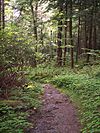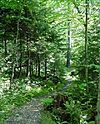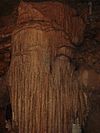List of National Natural Landmarks in West Virginia facts for kids
This is a list of the National Natural Landmarks (NNLs) in West Virginia. There are sixteen in all — five are wetlands (such as bogs and swamps), three are forests, six are limestone caves/karst, and two are rock formations. All are located entirely within West Virginia with the exception of the Cranesville Swamp Nature Sanctuary, which lies mostly within Garrett County, Maryland but also extends into Preston County, West Virginia. Eleven of the sixteen NNLs are within the boundaries of the Monongahela National Forest, although this does not necessarily mean they are on public land.
| Name | Image | Date | Location | County | Ownership | Description | |
|---|---|---|---|---|---|---|---|
| 1 | Bear Rocks and Allegheny Front Preserve | 2021 | Grant, Tucker | Private | The best example of a plateau within the Appalachian Plateaus Province. Supports a diverse and distinct ecological community. Located within the Monongahela National Forest and operated by The Nature Conservancy. | ||
| 2 | Big Run Bog | 1974 | Tucker | Federal | Located within the Monongahela National Forest, contains a high-altitude northern spruce bog. | ||
| 3 | Blister Run Swamp |  |
1974 | Pocahontas | Federal | A high-altitude balsam fir swamp located in Monongahela National Forest. | |
| 4 | Canaan Valley |  |
1974 | 39°07′36″N 79°22′41″W / 39.126667°N 79.378056°W | Tucker | Federal | Protects a boreal forest. Located in Canaan Valley National Wildlife Refuge. |
| 5 | Cathedral State Park |  |
1965 | 39°19′36″N 79°32′17″W / 39.326667°N 79.538056°W | Preston | State | Features a cool, dense hemlock forest. |
| 6 | Cranberry Glades Botanical Area |  |
1974 | 38°12′11″N 80°15′59″W / 38.203056°N 80.266389°W | Pocahontas | Federal | A bog forest, shrub thicket, and open glade in Monongahela National Forest. |
| 7 | Cranesville Swamp Nature Sanctuary |  |
1964 | 39°31′53″N 79°28′55″W / 39.531389°N 79.481944°W | Preston | Private | A natural bowl where cool, moist conditions yield plant and animal communities more common in northern latitudes. Extends into, and primarily located in, Garrett County, Maryland. Operated by The Nature Conservancy. |
| 8 | Fisher Spring Run Bog | 1974 | Grant | Federal | Contains a spruce bog. Located in Monongahela National Forest. | ||
| 9 | Gaudineer Scenic Area |  |
1974 | 38°37′41″N 79°50′33″W / 38.628056°N 79.8425°W | Randolph, Pocahontas |
Federal | A virgin red spruce forest in Monongahela National Forest. |
| 10 | Germany Valley Karst Area | 1973 | 38°45′54″N 79°23′24″W / 38.765°N 79.39°W | Pendleton | Mixed - federal, private | A unique intermountain karst area. | |
| 11 | Greenville Saltpeter Cave | 1973 | Monroe | Private | Protects the largest saltpeter cave in the state. | ||
| 12 | Ice Mountain | 2012 | 39°21′48″N 78°28′01″W / 39.363333°N 78.466944°W | Hampshire | Private | Supports a rich collection of boreal vascular plants. Operated by The Nature Conservancy. | |
| 13 | Lost World Caverns |  |
1973 | 37°49′57″N 80°26′49″W / 37.8326°N 80.4469°W | Greenbrier | Private | Cave contains pedestal-like stalagmites. |
| 14 | Organ Cave System |  |
1973 | 37°43′05″N 80°26′13″W / 37.718056°N 80.436944°W | Greenbrier | Private | Largest cave in West Virginia. |
| 15 | Shavers Mountain Spruce-Hemlock Stand | 1974 | Randolph | Federal | An old-growth stand of red spruce and hemlock trees. Part of Monongahela National Forest. | ||
| 16 | Sinnett-Thorn Mountain Cave System | 1973 | Pendleton | Private | Cave system with waterfalls and deep pits. |
De-designation
According to a notice in the Federal Register in July 2006, Swago Karst Area in Pocahontas County was removed by the Department of the Interior from NNL designation in response to owner requests. It was originally designated in November 1973. Its description formerly read: "A classic illustration of features associated with karst topography and terrain, including caverns and other passages."
See also

